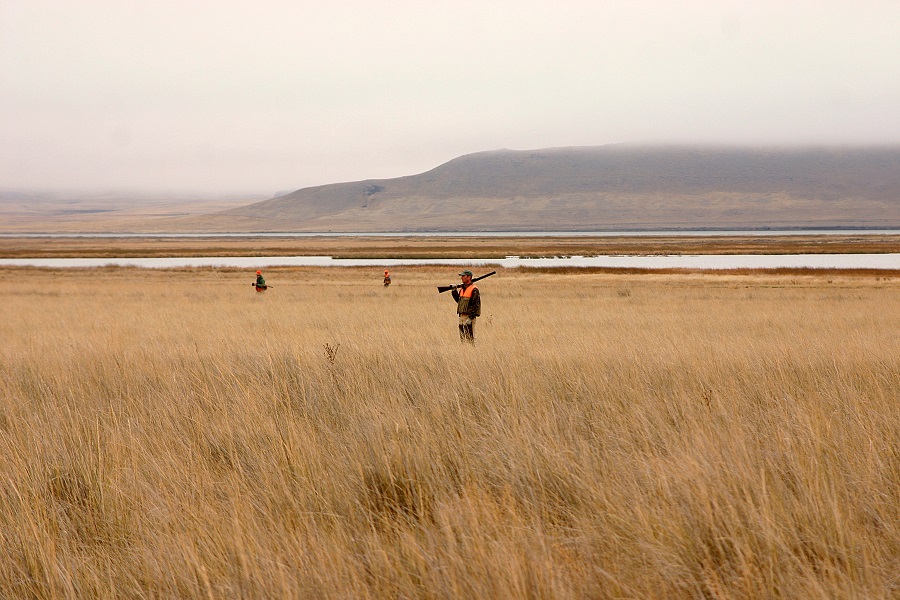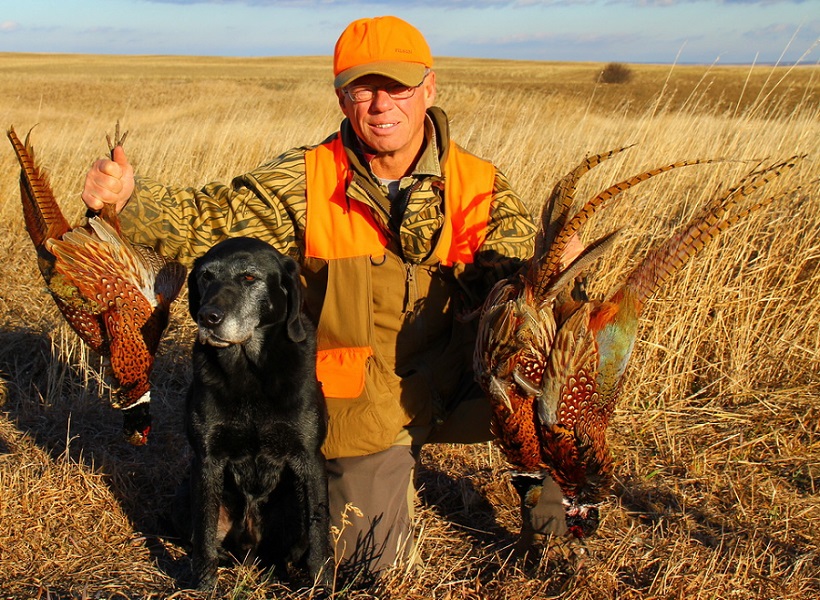It is considered one of the few remaining refuges for the rustic. “The Last Best Place,” some call it. A land dissected by rivers and marked by mountains in the west, with the vast Great Plains in the east. Its scenery has been immortalized and romanticized in books such as
A River Runs Through It and
Montana 1948, along with the stories of authors such as William Kittredge and Rick Bass. “Big Sky Country” – there is a timeless nature to its wilderness, as its lands remain mostly uncorrupted by steel frames and concrete.
With such a vast, untouched ecosystem, many species of animals – large, small and winged – inhabit the state’s brush and pines. Mystery permeates every hunt, as after covering miles of terrain, one can never know for certain what might flush next. Because of this, Montana remains a premiere destination for both big game and upland bird hunters. During the day, hunters experience the joys of working their dogs against the backdrop of a wide horizon, endless blue sky and the card catalog of mountain ranges. At night, relaxation arrives in the form of infinite stars, so brilliant and imposing, one might feel as if they could reach out and touch them.
Yet, whether as a result of work schedules, financial budgets or simply “ease of access,” so many hunters are postponing this dream trip, year after year. A few seasoned Montana authorities recently offered Pheasants Forever some advice for all those bird hunters interested in checking “Big Sky Country” off their bucket list.
“Montana offers great bird hunting opportunities for those looking to chase a wide range of species,” said Region 6 upland game bird biologist Ryan Williamson, “from pheasants, sharp-tailed grouse and Huns in eastern Montana, to blue, ruffed and spruce grouse in the mountains.” With a large amount of public land as well as private land open to hunting, according to Williamson, one would have a hard time not finding a good place to hunt.
Dan Bailey, Pheasants Forever Montana representative, offers this initial, key piece of advice: “Don’t get intimidated by the state. There are plenty of spots for folks to hunt. Find a spot that you want to explore. Learn to love it and you will keep coming back year after year.”

Bailey, originally from Wyoming, fell in love with Montana nearly 15 years ago and decided to make the state his home. “I think it’s the wide open country and the unique landscape,” he said. “You are running up coulees and mountains that hold birds. It’s great for people who love good bird dogs, since it’s a mix of knowing when to turn them loose and run big and when to keep them close and quiet. Different landscapes allow different ways to run the dogs.”
According to Bailey, any hunting parties traveling from the east will find themselves in good bird hunting country upon hitting the Montana border. “The northeast corner of the state gets the most hunters,” he said. “Communities up there really rely on out-of-state of hunters. If you draw a circle from any of these towns in eastern Montana and work your way out, you’re going to find birds.”
Bailey attests hunters will find greater success as a result of such initiatives as the Upland Game Bird Land Enhancement program and the Block Management program—a collaboration between private landowners and Montana Fish & Wildlife, which helps landowners manage hunting activities and provides the public with free hunting access to private lands. However, Bailey cautions against living and dying by Block Management booklets.
“You have to pick and choose which spots you go to—the only way to learn is getting out and running dogs,” Bailey said. “It’s big country—it’s a long way to drive from one section to the next. You can spend your time driving around a lot and you waste a lot of time driving. It’s best to pick a spot, make it your own, and learn it. You will have much better success then trying to run and gun across the state.”
When it comes time to start planning, Williamson recommends searching the Montana FWP
website and looking at different public access programs, habitat programs and ranges of each species of game bird you wish to chase. After identifying a species, pick out a general region or area and contact that area’s wildlife biologist who can help provide more detailed descriptions of the land and hunting opportunities.
“Montana is a big state and one will never cover it in a season,” Williamson said. “If targeting one particular species, I would suggest narrowing down a specific area and sticking to it.”
There are pheasants in pretty much every region, according to Bailey. “They are better in the eastern part of the state and central, though upland game opportunities are found all across the state. There are certain pockets where there are better bird numbers. It’s big, wide open country. You never know what is going to come up—it makes for exciting hunting.”

Minnesota resident and Pheasants Forever member, Chuck Kartak, has been chasing the flush in Montana for over 30 years. Though, like most hunters, he prefers not to divulge his honey spots, he did offer several succinct, useful steps for any bird hunter eager to tackle Montana.
To start off:
- Search the internet to tap others’ past experiences in online hunting forums, read outdoor magazines like Pheasants Forever and Gun Dog, and books by Montana writers such as Kicking Up Trouble: Upland Bird Hunting in the West by John Holt
- Contact the Montana Fish, Wildlife & Parks, since wildlife biologists and information officers are very responsive to inquiries
- Purchase and review maps of public hunting areas such as State Wildlife Management areas and National Wildlife Refuges
- Secure information on private access programs, known in Montana as Block Management Areas I or II
- Don’t overlook Indian reservation lands and their hunting opportunities
- Take a summer vacation or road trip to scout out potential areas for hunting, lodging, and camping opportunities
Progress in the following years by:
- Starting with public land, then Block Management land, and then over time request permission to hunt private land. Bear in mind: Securing landowner permission is easier later in the season when local upland hunters turn their pursuits to big game.
- Eating breakfast at local cafes and keeping your ears open to hunting conversation and potential opportunities (the same applies after the hunt in the evening at the local watering holes)
- Obeying all game laws and realizing that your actions with your out-of-state license plate will affect the reputation of your fellow hunters elsewhere
- Showing appreciation for Block Management land opportunities by leaving the landowners with a small gift, such as wild rice, maple syrup, etc.
- Hunting sharp-tailed grouse early in the season (September) while scouting pheasant hunting opportunities for October
Kartak notes pheasants and sharp-tailed grouse will get a bit spooky later in the season. “Not necessarily from intense hunting pressure,” he said, “but from coyotes and other predators keeping them on edge. Good dogs are a huge benefit.”
Also, according to Kartak, it is important to keep one’s expectations in check. “Montana has lost a tremendous amount of CRP acreage in the past five years,” he said. “Additional land has been developed for gas and oil exploration, increased irrigation for additional row crops, and new roads and other facility development.” Kartak recommends remaining flexible and remembering you will need to adapt to every change from Mother Nature and her landscape.
Finally, Bailey makes one request for any out-of-state hunters looking to visit Montana: “If you come out to Montana, don’t leave locking up a piece of land when you go—let’s keep the hunting access open to everyone. Montana residents value hunting access and don’t want to see it lost to out-of-state investors.”
Feel free to fall in love, but remain willing to share and help instill a love of Montana for years to come.
Story by John Hennessy. Passionate denizen of the outdoors and former line cook, John is the author of the blog “Braising the Wild.” Follow him on Twitter @WildGameJack.
Photo credit: Mark Herwig / Pheasants Forever